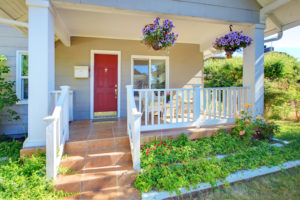
The front door is the mouth of a house. It says a lot. It can determine the overall aesthetic of an otherwise neutral facade. It can be the difference between modernity and nostalgia, modesty and pomp, privacy and carefree exhibitionism, security, and insecurity. But before you can get into all that, it’s best to figure out what material should comprise your door. If it’s your first time having to replace your door, you might be a little overwhelmed, as is natural with any home improvement move. Don’t worry! We got you.
Generally speaking, you’re wrestling with two options: wooden doors and synthetic fiberglass doors. There’s no right answer here. The type of door you should buy depends not only on your personal taste, but on your locale and its climate, your commitment to regular maintenance, and what you expect to get out of a door. We’ve got a wide selection of both wood and fiberglass doors at ETO Doors, and we’re going to go over the pros and cons of both wood and fiberglass, so you’ll be able to make the best, most informed decision.
The Benefits of Wooden Doors
We won’t lie: we love our wood doors. Wood is sturdy and beautiful. On a psychological level, wood puts us at ease in a way synthetic building materials like fiberglass, metal, and concrete just don’t. It’s relaxing and reassuring. Its reemerging reputation and related cost increase also means quality wood products have reacquired a bygone air of fanciness. A wood door with a natural finish and visible grain suggests class and luxury. It’s something to brag about, or at the very least, a conversation starter.
Beyond the aesthetic of wood, it’s also a dense, strong material. Solid core wood doors are especially rigid and resistant — a would-be burglar stands little chance against a solid wood door, unless he brought his chainsaw — so those who prioritize home security should be happy campers. There’s also the fact that solid wood is rather good at insulating from sound, keeping your conversations in and the noise of the world out. And at the end of the day, doesn’t it feel better to have a door made from a renewable resource like wood? ETO Doors are committed to supporting sustainable forestry, so you can rest assured none of our doors contribute to deforestation.
The Drawbacks of Wooden Doors
Of course, there are some cons. The most prevalent one? Maintenance, or what happens in its absence. Natural wood will expand and contract as the climate changes, meaning you might have to replace your weather stripping a little more often to prevent leaks. Speaking of leaks, wood is not impervious to water. Unless your entryway is situated on a covered porch or under an awning, expect the elements to do a number on that wood over time. In a worst-case scenario, a wood door may even incur some rot, cutting its lifespan short.
In order to keep a wood door in top shape, you’ll want to re-stain it, or re-paint it, every few years or so. As long as you have a sealing barrier between the wood itself and nature’s harsh embrace, you should be able to enjoy your wood door for the extent of its advertised lifespan.
The Benefits of Fiberglass Doors
With fiberglass doors, the benefits over wood are immediately apparent and hard to ignore. Right away, you may notice the difference in price. There’s no getting around it: fiberglass doors, especially in today’s market, are more affordable than their wooden counterparts. Like wood doors, they can be fabricated in just about any style, and can even be manufactured with wood veneers or laminates for those wishing to hold on to the timeless appearance of wood.
Fiberglass doors also have a slight leg up on wood doors when it comes to temperature insulation and energy efficiency. While solid core wood doors are no slouches in the insulation department, fiberglass is better able to retain heat in the winter and repel it in the summer. Fiberglass is also about as strong as wood while being considerably lighter.
The Drawbacks of Fiberglass Doors
While fiberglass may be more affordable than wood on average, fiberglass remains one of the more expensive synthetic construction materials, and the budget-focused will still have cheaper options. Fiberglass is also a difficult material to trim and adjust, compared to easily worked wood, so fiberglass doors will be limited to the most common measurements. Those requiring unusual dimensions may find it difficult to source properly sized fiberglass doors, and reshaping them is a Herculean labor. You’ll be lucky to find a vendor who offers trimmable fiberglass doors. (Oh, wait — we offer trimmable fiberglass doors!)
Another disadvantage of fiberglass doors, which turns off many potential buyers, is their proprietary framing. Unlike wood doors, the vast majority of fiberglass doors come pre-installed in their own frame, meaning they cannot be installed in existing door frames. That means that when you buy a fiberglass door, you’re not only replacing your old, worn-out door, but you’re replacing what might be a perfectly good, usable frame.
We’re always here to answer any questions about door materials, door styles, and door warranties. Don’t be afraid to contact ETO Doors to find out more about our wooden and fiberglass door options.


